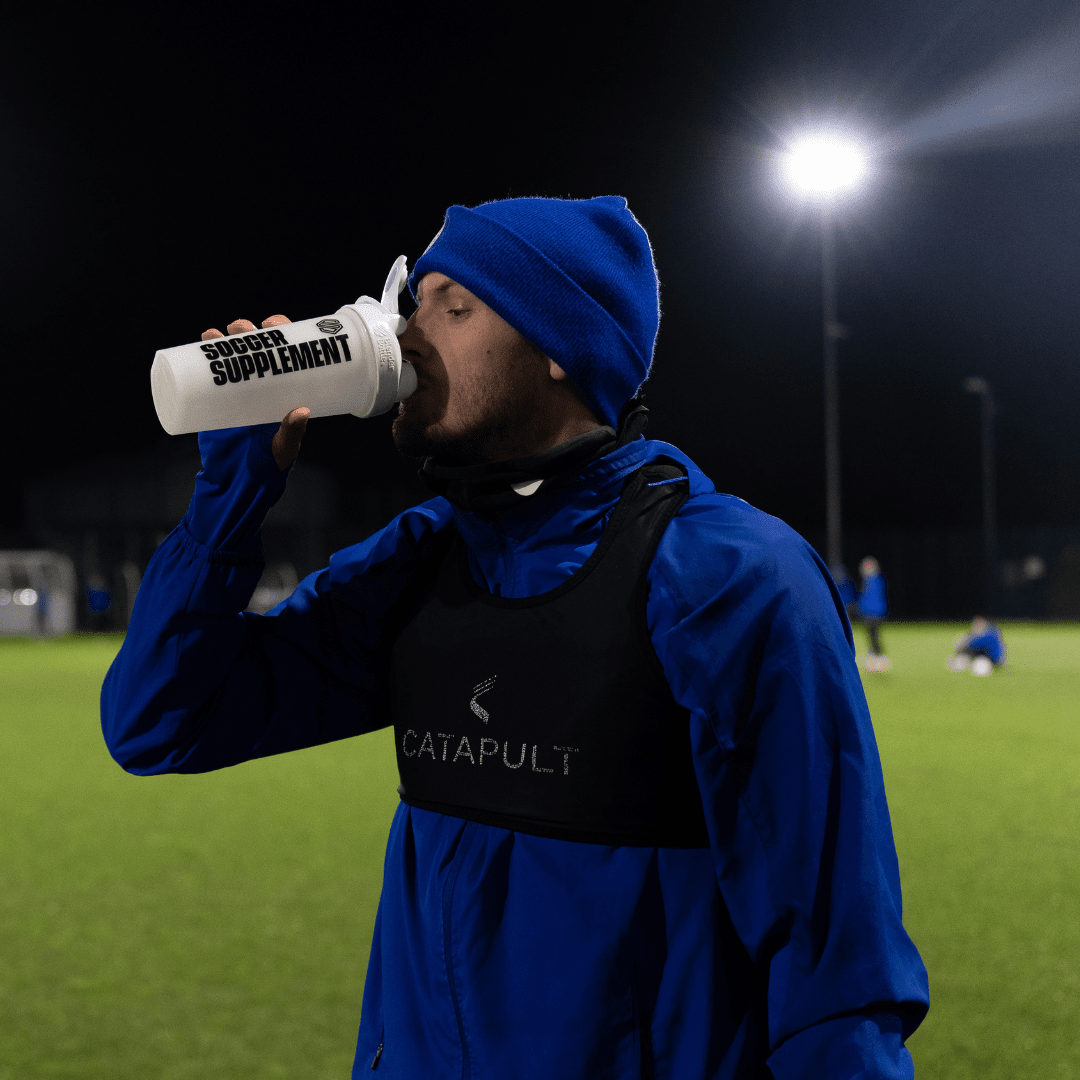Introduction
In this post, we take a look at football nutrition and what is required of a Footballers diet as a whole, in order to perform at the elite level of the game.
In our three previous articles, we discussed the importance of pre, during and post-match football nutrition for football players, which hopefully gave you some useful takeaways. In this article, I aim to provide some context to these recommendations and describe how to best set up your diet as a whole.
The framework that I use to create a diet focuses on setting individual macronutrient requirements in four steps. After estimating total maintenance calories (1), I set protein (2), then fat (3) and let carbohydrate make up the remainder (4).
1. Estimating total energy expenditure
When speaking of a maintenance caloric intake, what I really mean is a caloric intake
that will more or less match energy expenditure, hence, maintain body mass. Total energy expenditure (TEE) consists of resting energy expenditure (REE) or basal metabolic rate (BMR), thermic effect of activity and the thermic effect of food (TEF).
While technically not the same thing, REE and BMR are often used interchangeably, and for all practical purposes, their differences are nothing to be concerned with when estimating caloric needs. REE/BMR pretty much represents the energy cost of sustaining life and is measured at rest in a fasted state. TEA includes the energy cost of all physical activity, both voluntary and involuntary (i.e. non-exercise activity thermogenesis).
Non-exercise activity thermogenesis (NEAT), which makes up approximately 15-30% of TEA, includes things such as shivering, fidgeting and anything else that involves movement but isn’t really classed as exercise.1 TEF accounts for the average thermic effects of the macronutrients during digestion and roughly accounts for 10-15% of TEE. The TEFs for the individual macronutrients are: protein (25-30%), carbohydrate (6-8%), fat (2-3%).2
As TEE is made up of the sum of REE/BMR, TEA and TEF, we have to be able to measure, or, at least estimate these individual components in order to work out an individual’s daily caloric requirements. Since most reading this won’t have access to a lab in order to measure REE/BMR, we have to estimate it using one of many prediction equations. The ‘Harris-Benedict’, ‘Mifflin-St Jeor’ and ‘Owen’ equations are the most popular ones in use, with the ‘Mifflin-St Jeor’ equation being the most reliable of the three.3 The equations are outlined below:
Harris-Benedict:
Men: 66 + (13.75 x weight) + (5 x height) - (6.76 x age)
Women: 655 + (9.56 x weight) + (1.85 x height) - (4.68 x age)
Mifflin-St Jeor:
Men: (10 x weight) + (6.25 x height) - (5 x age) + 5
Women: (10 x weight) + (6.25 x height) - (5 x age) - 161
Owen:
Men: 879 + (10.2 x weight) Women: 795 + (7.2 x weight).
What I use:
Men: 23 x weight. Women: 21.5 x weight
(where height is in centimetres, weight is in kilograms and age is in years)
I have also included the one I use with footballers, which is much simpler yet seems to produce values in line with the more complex equation. To illustrate this, I’ll run Cristiano Ronaldo’s stats through each equation and report his REE/BMR for each, where height = 185, weight = 82 and age = 31 (table 1.).
Table 1. Ronaldo’s estimated REE/BMR based on popular equations.
|
Equation Used |
Estimated REE/BMR |
|
Harris-Benedict |
1909 |
|
Mifflin-St Jeor |
1821 |
|
Owen |
1715 |
|
What we use |
1886 |
As you can see from table 1, there is little difference between all the estimations. If anything, the Owen equation appears to be the odd one out in this instance. Given that the Harris-Benedict and Mifflin-St Joer equations take weight, height and age into account, there may be some discrepancies between those and my equation (which only takes body weight into account), at the extreme ranges of such values. However, for all commonly encountered/ realistic ranges in height, body weight and age, all four equations will produce very similar estimations.
Now that REE/BMR is taken care of, we need to factor in activity (TEA) and the thermic effect of food (TEF). Depending on the type, intensity, duration, and frequency of physical activity, energy needs for physical activity may vary from ~20% to 70% or more of REE/BMR. To estimate this energy need, you can multiply the previously estimated REE/BMR by and activity factor that is most similar to you your current training routine and lifestyle/job:
- Sedentary = BMR X 1.2 (little or no exercise, desk job)
- Lightly active = BMR X 1.375 (light exercise/sports 1-3 days/wk)
- Moderately active = BMR X 1.55 (moderate exercise/sports 3-5 days/wk)
- Very active = BMR X 1.725 (hard exercise/sports 6-7 days/wk)
- Extremely active = BMR X 1.9 (hard daily exercise/sports & physical job or 2X day training, e.g. marathon, contest etc.)
As you can see, most footballers (recreational and professional) will fall between the moderately active and very active energy factors. It’s worth noting that these various activity factors are quite generalised and therefore can have significant margins of error, thus negating the need to factor in 10-15% for the TEF. For this reason, an estimated maintenance caloric intake shouldn’t take precedence over real world changes in body mass or composition. Those who are aware of their maintenance needs (i.e. are weight stable for relatively long periods of time) and daily caloric intake needn’t bother with these estimations since they only serve to set a ball park estimate of maintenance caloric intake.
Using Ronaldo as an example, again, his activity levels would probably fall about the 1.8 activity factor mark. This equates to a total daily energy expenditure of roughly 3395kcal. Now maintenance calorie needs are estimated (based on equations or real-world observations) we can go about filling this calorie allotment with varying proportions of macronutrients based on individual needs or preferences.
2. Setting protein intake
With the more complicated stuff out of the way, the next step of filling the calories with the macronutrients is really simple. The recommended daily allowance (RDA) for protein is set at 0.8 grams per kilogram of bodyweight (g/kgBW), while research typically recommends intakes of 1.4-2.2 g/kgBW for athletic populations (i.e. from endurance to strength athletes). I tend to err on the side of too much than too little protein and therefore recommend intakes between 1.8-2.2 g/kgBW for football players. Such intakes are realistically achievable by most and wouldn’t seem to impede on carbohydrate requirements of athletes for a given energy budget.
3. Setting fat intake
Unlike protein there isn’t really an evidenced-based dosing range to cite when talking about fat intake. As long as essential fatty acid intake is met, which is virtually impossible not to with a typical diet, fat intake technically doesn’t have to be any higher. Having said that, calories have to come from somewhere. Furthermore, in order for a diet not to be bland, in addition to there being enough fat to optimise the absorption of fat soluble vitamins, I like to use intakes of 1-1.5 g/kg as a starting point, which suit both recreational and elite-level footballers (due to the contribution of intramuscular triglycerides [IMTG] as a fuel source during matches) alike.
4. Setting carbohydrate intake
Now that we’ve set total calories, protein and fat, carbohydrates simply fill the remaining calorie allotment. Using Cristiano again as an example, I’ll run through steps 1-4 based on his stats and training/activity.
i. REE/BMR = 23 x 82kg = 1886 kcal. Since the “very active” activity factor most accurately represents his current activity I’ll multiply his REE/BMR by 1.8 (1886 x 1.8) giving a TEE of 3395kcals per day.
ii. Since his athletic goals include maintaining muscle mass and strength, I’ll set protein intake at the upper end (2.2g/kg of BW). This equates to a daily protein intake of (82 x 2.2) 180g. As each gram of protein contains roughly 4 kcals, daily protein intake equates to 720 kcals.
iii. As CR would deplete a significant amount of IMTG through training, and has a high energy expenditure, I’ll set fat intake at the upper end of my recommendations (1.5g/kg). This equates to a daily fat intake of (82 x 1.5) 123 g. As each gram of fat contains roughly 9 kcals, daily fat intake equates to 1107 kcals.
iv. To calculate carbohydrate intake in grams, all we need to do is subtract the sum of protein and fat kcals from total kcals, then divide by 4 (the amount of kcals per gram of carbohydrate)
a. Protein = 180 x 4 kcal/g = 720 kcals
b. Fat = 123 x 9 kcal/g = 1107 kcal
c. TEE (3395 kcals) – 1827 (720 + 1107) = 1568 kcals from carbohydrate.
d. 1568 / 4 (number of kcals per gram of carbohydrate) = 392 g
Totals:
Energy: 3395 kcal
Protein: 180 g (21%)
Fat: 123 g (33%)
Carbs: 392 g (46%)
This whole process is pretty straightforward and should take a few minutes at most since all you need to know is your current body weight and training volume/frequency.
From there, you would split the macronutrients up over a realistic number of meals (3-5) over the course of the day and aim to meet these individual macronutrient goals.
Though total macronutrient intake would seem to have the greatest overall impact compared with any single dietary modification, other variables such as: nutrient timing, meal frequency, macronutrient subtype, nutrient density (vitamin and mineral content per calorie), non-nutritive dietary components and supplementation, would have a measurable impact on body composition, sporting performance and health. That is assuming the ability of an individual to successfully implement a desired macronutrient intake on a daily basis in the first place.
That’s it. Hopefully this guide to football nutrition has shed some light on how to properly construct the backbone of a diet (i.e. the macronutrient content) in a simple and individualised manner.
Joseph Agu MSc.
Head of Science
Soccer Supplement®
Click here to shop our range of Footballer Performance Supplements
References
1. Genton, L., Melzer, K. & Pichard, C. Energy and macronutrient requirements for physical fitness in exercising subjects. Clin. Nutr. 29, 413–23 (2010).
2. Jéquier, E. Pathways to obesity. Int. J. Obes. Relat. Metab. Disord. 26 Suppl 2, S12-7 (2002).
3. Frankenfield, D., Roth-Yousey, L. & Compher, C. Comparison of predictive equations for resting metabolic rate in healthy nonobese and obese adults: a systematic review. J. Am. Diet. Assoc. 105, 775–89 (2005).
















